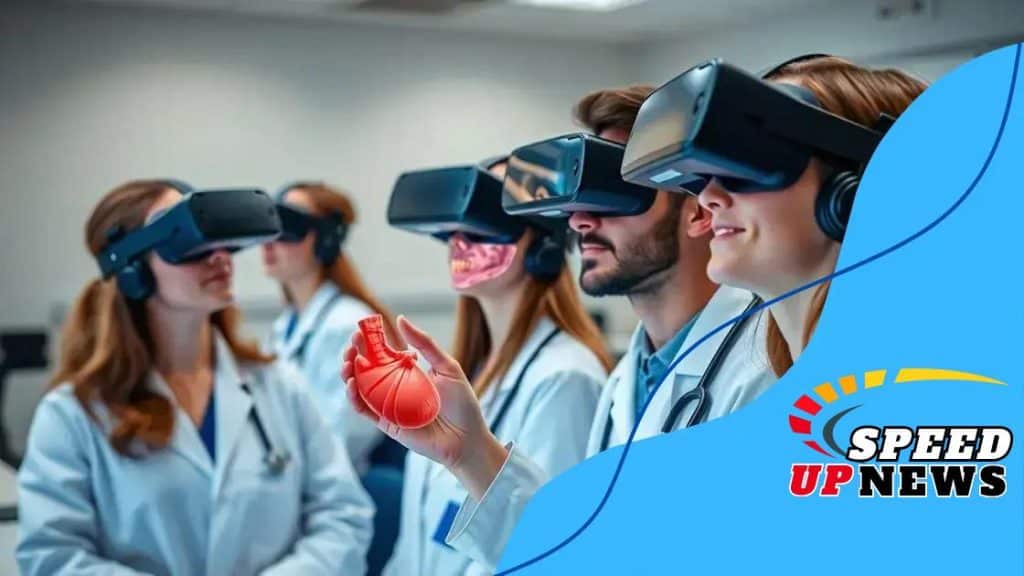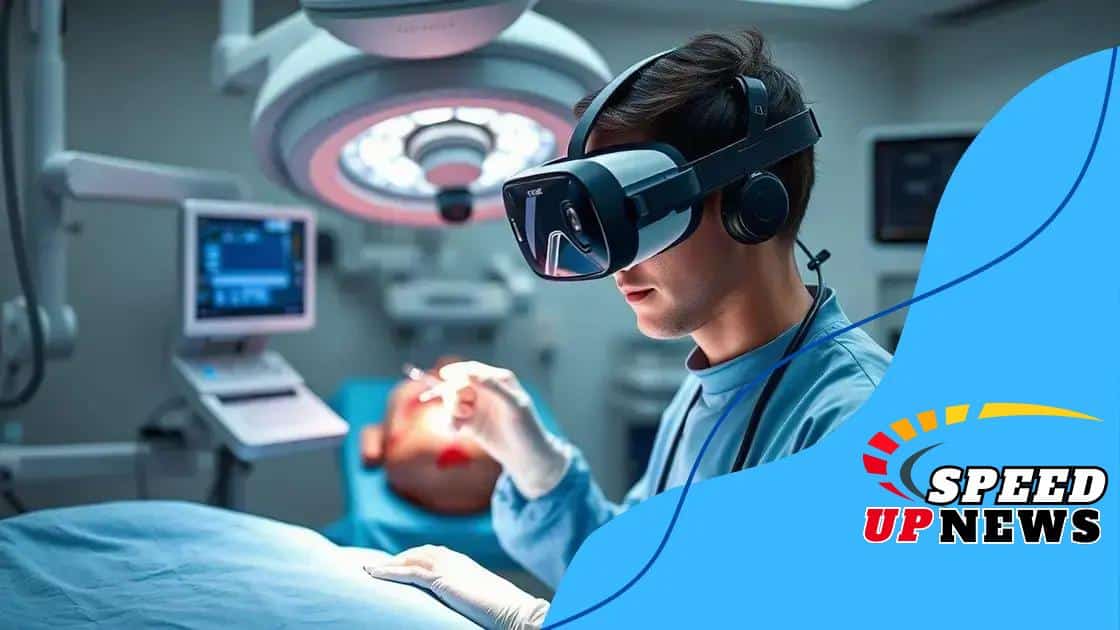Virtual reality in medical education and training: A game changer

Virtual reality in medical education and training enhances learning by providing immersive experiences, allowing students to practice skills in realistic scenarios while improving patient care through engaging therapies.
Virtual reality in medical education and training is transforming how future healthcare professionals learn and practice. Imagine stepping into a simulated operating room without leaving your classroom—sounds exciting, right? Let’s dive into how VR can reshape the way we train our medical professionals.
Understanding virtual reality technology
Understanding virtual reality technology is essential in the context of modern education. This technology enables immersive learning experiences that reshape how students grasp complex medical concepts. By using VR, educators can simulate real-life scenarios, enhancing engagement and retention.
What is virtual reality?
Virtual reality (VR) is a computer-generated simulation that allows users to interact with a three-dimensional environment. This environment can mimic real-world settings or create entirely fictional worlds. Users typically wear VR headsets that provide a lifelike experience, making them feel as if they are part of the virtual world.
Key components of VR technology
- Hardware: High-quality VR headsets, sensors, and controllers are crucial for a seamless experience.
- Software: Programs and applications designed for educational purposes allow for simulations tailored to specific learning objectives.
- Content creation: Developing realistic scenarios and environments enhances the effectiveness of training.
The combination of these components creates an effective learning tool in medical education. For example, students can practice surgical techniques without the risks associated with real-life procedures. Instead of reading about anatomy from textbooks, they can visualize and manipulate 3D models directly, which reinforces learning.
Moreover, virtual reality can cater to different learning styles. Some students may grasp concepts better through visual interaction, while others benefit from hands-on practice. VR encompasses both, providing tailored experiences suited to various preferences.
As educators continue to embrace this technology, understanding its fundamentals becomes increasingly important. By weaving together theoretical knowledge and practical experience, VR paves the way for a new era of medical training that is more effective and engaging.
How VR revolutionizes medical training
How VR revolutionizes medical training is a fascinating topic that highlights changes in educational methods. With traditional training methods, students often rely on textbooks and lectures, but virtual reality transforms these methods into interactive experiences. For instance, students can step into a realistic simulation of an operating room.
The impact of immersive experiences
Immersive experiences provided by VR have significantly enhanced learning and retention. By engaging multiple senses, students find it easier to understand complex medical procedures. They can practice diagnoses and treatments in a risk-free environment, allowing them to make mistakes and learn from them without jeopardizing patient safety.
Benefits of VR in medical training
- Increased engagement: Students are more likely to be excited about learning when using VR, making education feel like a game.
- Real-time feedback: Immediate responses during simulations help students adjust their techniques on the spot.
- Accessibility: VR technology can make high-quality training accessible to students regardless of location or resources.
- Skill development: Repeated practice in a controlled environment builds confidence and competence.
Furthermore, VR allows instructors to track student performance, gathering valuable data to fine-tune educational approaches. In this way, teachers can adapt the training to meet the unique needs of each student. This personalized coaching further enhances the learning experience.
As technology develops, the possibilities for virtual reality in medical training will only expand. Healthcare providers can simulate rare procedures, improving preparedness and outcomes in real-world situations. Imagine a new surgeon practicing complex techniques before the actual surgery. This reality is becoming achievable thanks to the power of VR.
Benefits of immersive simulations for students

The benefits of immersive simulations for students are numerous, especially in the field of medical education. By engaging in realistic scenarios, students gain firsthand experience that enhances their learning process. These simulations provide a safe environment for students to make mistakes and learn valuable lessons.
Enhanced learning experiences
Immersive simulations invite students to dive deep into the content. They are not just passive listeners; students become active participants, which improves retention. This type of learning is more effective than traditional methods since it allows students to practice skills repeatedly until they feel confident.
Key advantages of immersive simulations
- Realistic practice: Students can experience lifelike situations that they will encounter in their careers, making them better prepared for real-life challenges.
- Immediate feedback: Simulations often provide instant feedback, allowing students to identify and correct their mistakes quickly.
- Increased engagement: The interactive nature of simulations keeps students interested and motivated to learn.
- Teamwork development: Many simulations require students to work together, fostering collaboration and communication skills.
Furthermore, immersive simulations cater to various learning styles. Some students may find traditional lectures dull, but this hands-on approach sparks enthusiasm. By interacting with the material, students can visualize concepts, leading to deeper understanding and appreciation of the subject matter.
Virtual reality allows students to experiment freely, building confidence in their skills. They learn not only from their successes but also from their challenges. This hands-on experience is invaluable as it fosters critical thinking and problem-solving abilities.
Challenges of implementing VR in education
Implementing VR in education brings several challenges that must be addressed. While the benefits are clear, there are obstacles that educators and institutions face in adopting this technology. Understanding these challenges is crucial for effective integration.
Technical limitations
The first challenge involves the technical limitations of VR technology. Not all schools have the necessary hardware or software to implement these immersive experiences. Upgrading or purchasing new devices can be expensive. Furthermore, ensuring that the technology is user-friendly is vital for student engagement.
Training educators
Another challenge is the need for proper training for educators. Teachers must understand how to use VR tools effectively. Without proper training, they may struggle to integrate virtual reality into their curriculum. Professional development programs should be established to equip educators with the skills they need.
Cost factors
- Initial investment: The cost of VR hardware can be a major barrier for many educational institutions.
- Maintenance: Keeping VR systems updated and operational requires ongoing financial support.
- Content creation: Developing high-quality VR educational content can be costly and time-consuming.
Additionally, some institutions may face challenges in their infrastructure. Not every school is prepared for the technical requirements that VR demands. Internet connectivity and access to suitable space for VR activities are essential for implementing effective programs.
Moreover, there can be resistance to change from both educators and students. Some might prefer traditional teaching methods and may feel uncomfortable adapting to new technology. This cultural shift requires time, patience, and strong leadership to guide everyone through the transition.
Future trends of virtual reality in healthcare
The future trends of virtual reality in healthcare are promising, showing great potential to enhance education and patient care. As technology advances, we can expect even more innovative applications that will shape the landscape of medical training.
Advancements in technology
With the rapid pace of technology, VR systems are becoming more affordable and accessible. This means that more medical schools can integrate VR into their curricula. For instance, improved hardware and software will allow for even more realistic simulations, making the learning experience richer. As these tools evolve, they will increasingly replicate real-life medical situations with high fidelity.
Increased focus on patient care
Another trend is the growing use of virtual reality for patient treatment. VR can be beneficial for pain management, anxiety reduction, and rehabilitation. For example, patients undergoing physical therapy can engage in VR experiences that motivate them to perform exercises in a fun and engaging way.
Key trends to watch
- Telemedicine integration: Combining VR with telemedicine can provide remote consultations, making healthcare more accessible.
- Expanding training programs: More specialized VR training programs for specific medical fields will emerge, providing targeted education.
- Data analytics: Utilizing data from VR experiences will help tailor training and improve patient outcomes.
- Collaboration tools: VR can enhance collaboration among healthcare professionals, making team-based care more effective.
As these trends gain traction, we can expect a shift in how medical professionals are trained and how patient interactions occur. The immersive nature of VR is reshaping the healthcare industry, creating opportunities for more personalized and effective care.
Moreover, ongoing research will likely discover new applications of virtual reality in mental health, surgical training, and emergency response. As healthcare continues to embrace digital transformation, VR will play a vital role in developing innovative solutions for today’s challenges.
In conclusion, the role of virtual reality in medical education and healthcare is transforming how we learn and practice medicine. It offers immersive experiences that enhance understanding and retention. As we look to the future, advancements in VR technology will continue to reshape our training and patient care, making them more effective and engaging. Challenges still exist, but the potential benefits outweigh these issues, paving the way for a new era in healthcare education.
FAQ – Frequently Asked Questions about Virtual Reality in Healthcare
How does virtual reality enhance medical training?
Virtual reality provides immersive experiences that allow students to practice skills in realistic scenarios, improving retention and understanding.
What are the benefits of using VR for patient care?
VR can help manage pain, reduce anxiety, and enhance rehabilitation, making treatments more engaging and effective for patients.
What challenges do educational institutions face when implementing VR?
Challenges include the high cost of technology, the need for educator training, and technical limitations in schools.
What future trends can we expect in virtual reality for healthcare?
We can expect advancements in technology, increased patient engagement, and the integration of VR into telemedicine and specialized training programs.





